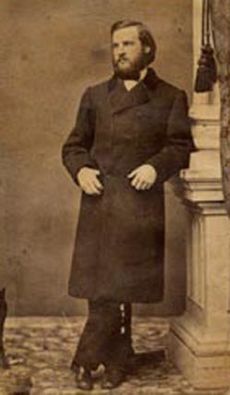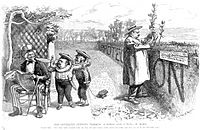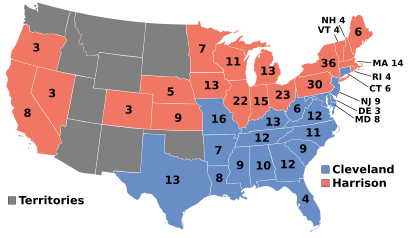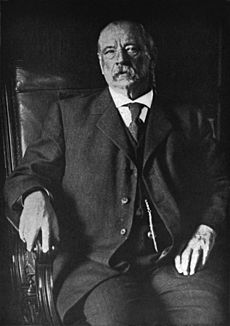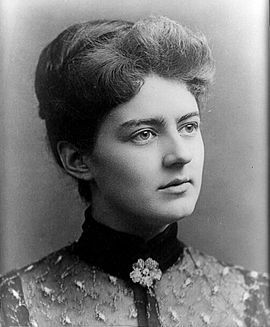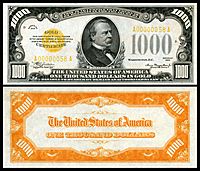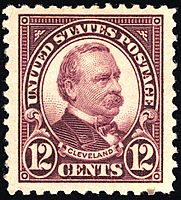Grover Cleveland facts for kids
Quick facts for kids
Grover Cleveland
|
|
|---|---|
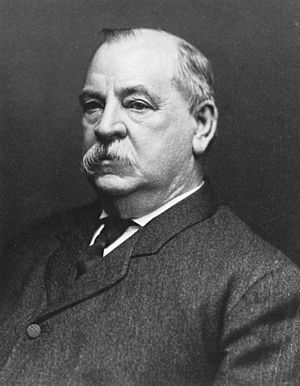 |
|
| 22nd & 24th President of the United States | |
| In office March 4, 1893 – March 4, 1897 |
|
| Vice President | Adlai Stevenson I |
| Preceded by | Benjamin Harrison |
| Succeeded by | William McKinley |
| In office March 4, 1885 – March 4, 1889 |
|
| Vice President |
|
| Preceded by | Chester A. Arthur |
| Succeeded by | Benjamin Harrison |
| 28th Governor of New York | |
| In office January 1, 1883 – January 6, 1885 |
|
| Lieutenant | David B. Hill |
| Preceded by | Alonzo B. Cornell |
| Succeeded by | David B. Hill |
| 35th Mayor of Buffalo | |
| In office January 2, 1882 – November 20, 1882 |
|
| Preceded by | Alexander Brush |
| Succeeded by | Marcus M. Drake |
| 17th Sheriff of Erie County | |
| In office January 1, 1871 – December 31, 1873 |
|
| Preceded by | Charles Darcy |
| Succeeded by | John B. Weber |
| Personal details | |
| Born |
Stephen Grover Cleveland
March 18, 1837 Caldwell, New Jersey, U.S. |
| Died | June 24, 1908 (aged 71) Princeton, New Jersey, U.S. |
| Resting place | Princeton Cemetery |
| Political party | Democratic |
| Spouse | |
| Children | 6, including Ruth, Esther, Richard, and Francis |
| Parent |
|
| Relatives |
|
| Occupation |
|
| Signature | |
Stephen Grover Cleveland (March 18, 1837 – June 24, 1908) was an American politician who served as the 22nd and 24th president of the United States from 1885 to 1889 and from 1893 to 1897. Cleveland is the only president in U.S. history to serve non-consecutive presidential terms.
He was known for his honesty, integrity, and having a firm stance against corruption.
He won the popular vote in three presidential elections—1884, 1888, and 1892. Benjamin Harrison won the electoral college vote, and thus the presidency, in 1888. Cleveland was one of two Democrats elected president (followed by Woodrow Wilson in 1912) in an era when Republicans dominated the presidency between 1861 and 1933.
Cleveland was a formidable policymaker, but also garnered criticism. Critics complained that Cleveland had little imagination and seemed overwhelmed by the nation's economic disasters—depressions and strikes—in his second term.
By the end of his second term, he was severely unpopular, even among Democrats. After leaving the White House, Cleveland lived in retirement at his estate, Westland Mansion, and served as a trustee of Princeton University. He continued to voice his political views, but fell seriously ill during the autumn of 1907. He died in 1908, aged 71.
Contents
Early life and education
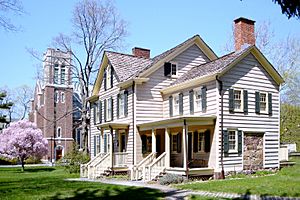
Stephen Grover Cleveland was born on March 18, 1837, in Caldwell, New Jersey, to Ann (née Neal) and Richard Falley Cleveland. Cleveland's father was a Congregational and Presbyterian minister who was originally from Connecticut. His mother was from Baltimore and was the daughter of a bookseller.
Cleveland was the fifth of nine children. In 1841, the Cleveland family moved to Fayetteville, New York, where Grover spent much of his childhood. Neighbors later described him as "full of fun and inclined to play pranks", and fond of outdoor sports.
Cleveland received his elementary education at the Fayetteville Academy and the Clinton Liberal Academy. After his father died in 1853, he left school to help support his family. Later that year, Cleveland's brother William was hired as a teacher at the New York Institute for the Blind in New York City, and William obtained a place for Cleveland as an assistant teacher. Cleveland returned home to Holland Patent at the end of 1854, where an elder in his church offered to pay for his college education if he would promise to become a minister. Cleveland declined, and in 1855 he decided to move west.
Early career
He stopped first in Buffalo, New York, where his uncle-in-law Lewis F. Allen, gave him a clerical job. Allen was an important man in Buffalo, and he introduced his nephew-in-law to influential men there, including the partners in the law firm of Rogers, Bowen, and Rogers. Cleveland later took a clerkship with the firm, began to read the law with them, and was admitted to the New York bar in 1859.
Cleveland worked for the Rogers firm for three years before leaving in 1862 to start his own practice. In January 1863, he was appointed assistant district attorney of Erie County.
As a lawyer, Cleveland became known for his single-minded concentration and dedication to hard work. During this time, Cleveland assumed a lifestyle of simplicity, taking residence in a plain boarding house. He devoted his growing income instead to the support of his mother and younger sisters.
Political career
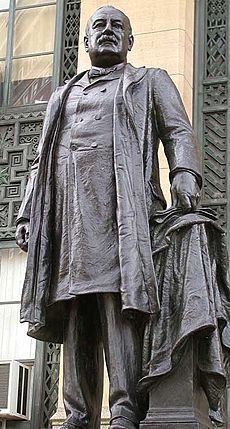
From his earliest involvement in politics, Cleveland aligned with the Democratic Party. In 1870, with the help of friend Oscar Folsom, Cleveland secured the Democratic nomination for sheriff of Erie County, New York. While this new career took him away from the practice of law, it was rewarding in other ways: the fees were said to yield up to $40,000 (equivalent to $977,111 in 2022) over the two-year term. Cleveland's service as sheriff was unremarkable and after his term as sheriff ended, Cleveland returned to his law practice, opening a firm with his friends Lyman K. Bass and Wilson S. Bissell. Elected to Congress in 1872, Bass did not spend much time at the firm, but Cleveland and Bissell soon rose to the top of Buffalo's legal community.
In 1881, Cleveland was elected mayor of Buffalo and governor of New York in 1882. His fight against political corruption won him popular acclaim and convinced many like-minded Republicans, called "Mugwumps", to cross party lines and support him in the 1884 election.
First presidency (1885–1889)
Soon after taking office, Cleveland was faced with the task of filling all the government jobs for which the president had the power of appointment. These jobs were typically filled under the spoils system, but Cleveland announced that he would not fire any Republican who was doing his job well, and would not appoint anyone solely on the basis of party service. He also used his appointment powers to reduce the number of federal employees, as many departments had become bloated with political time-servers. While some of his decisions were influenced by party concerns, more of Cleveland's appointments were decided by merit alone than was the case in his predecessors' administrations.
Cleveland also reformed other parts of the government. In 1887, he signed an act creating the Interstate Commerce Commission. He and Secretary of the Navy William C. Whitney undertook to modernize the navy and canceled construction contracts that had resulted in inferior ships. Cleveland angered railroad investors by ordering an investigation of western lands they held by government grant. Secretary of the Interior Lucius Q. C. Lamar charged that the rights of way for this land must be returned to the public because the railroads failed to extend their lines according to agreements. The lands were forfeited, resulting in the return of approximately 81,000,000 acres (330,000 km2).
Cleveland was opposed to high tariffs, free silver, inflation, imperialism, and subsidies to business, farmers, or veterans.
Cleveland's military policy emphasized self-defense and modernization. In 1885 Cleveland appointed the Board of Fortifications under Secretary of War William C. Endicott to recommend a new coastal fortification system for the United States. Most of the Board's recommendations were implemented, and by 1910, 27 locations were defended by over 70 forts. Many of the weapons remained in place until scrapped in World War II as they were replaced with new defenses.
Cleveland, like a growing number of Northerners and nearly all white Southerners, saw Reconstruction as a failed experiment, and was reluctant to use federal power to enforce the 15th Amendment of the U.S. Constitution, which guaranteed voting rights to African Americans. Though Cleveland appointed no black Americans to patronage jobs, he allowed Frederick Douglass to continue in his post as recorder of deeds in Washington, D.C., and appointed another black man (James Campbell Matthews, a former New York judge) to replace Douglass upon his resignation. His decision to replace Douglass with a black man was met with outrage, but Cleveland claimed to have known Matthews personally.
Cleveland believed that Chinese immigrants were unwilling to assimilate into white society. Secretary of State Thomas F. Bayard negotiated an extension to the Chinese Exclusion Act, and Cleveland lobbied the Congress to pass the Scott Act, written by Congressman William Lawrence Scott, which prevented the return of Chinese immigrants who left the United States. The Scott Act easily passed both houses of Congress, and Cleveland signed it into law on October 1, 1888.

Cleveland viewed Native Americans as wards of the state, saying in his first inaugural address that "[t]his guardianship involves, on our part, efforts for the improvement of their condition and enforcement of their rights." He encouraged the idea of cultural assimilation, pushing for the passage of the Dawes Act, which provided for the distribution of Indian lands to individual members of tribes, rather than having them continued to be held in trust for the tribes by the federal government. While a conference of Native leaders endorsed the act, in practice the majority of Native Americans disapproved of it. Cleveland believed the Dawes Act would lift Native Americans out of poverty and encourage their assimilation into white society. It ultimately weakened the tribal governments and allowed individual Indians to sell land and keep the money.
Election of 1888 and return to private life (1889–1893)
The Republicans nominated Benjamin Harrison, the former U.S. Senator from Indiana for president and Levi P. Morton of New York for vice president. Cleveland was renominated at the Democratic convention in St. Louis. As in 1884, the election focused on the swing states of New York, New Jersey, Connecticut, and Indiana. But unlike that year, when Cleveland had triumphed in all four, in 1888 he won only two, losing his home state of New York by 14,373 votes. Cleveland won a plurality of the popular vote – 48.6 percent vs. 47.8 percent for Harrison – but Harrison won the Electoral College vote easily, 233–168.
As Frances Cleveland left the White House, she told a staff member, "Now, Jerry, I want you to take good care of all the furniture and ornaments in the house, for I want to find everything just as it is now, when we come back again." When asked when she would return, she responded, "We are coming back four years from today." In the meantime, the Clevelands moved to New York City, where Cleveland took a position with the law firm of Bangs, Stetson, Tracy, and MacVeigh. Cleveland's law practice brought only a moderate income, perhaps because Cleveland spent considerable time at the couple's vacation home Gray Gables at Buzzard Bay, where fishing became his obsession. While they lived in New York, the Clevelands' first child, Ruth, was born in 1891.
Second presidency (1893–1897)
Shortly after Cleveland's second term began, the Panic of 1893 struck the stock market, and he soon faced an acute economic depression. Having succeeded in reversing the Harrison administration's silver policy, Cleveland sought next to reverse the effects of the McKinley Tariff. The Wilson–Gorman Tariff Act passed the House by a considerable margin. The bill proposed moderate downward revisions in the tariff, especially on raw materials. The shortfall in revenue was to be made up by an income tax of two percent on income above $4,000 (equivalent to $130,281 in 2022).
The bill was next considered in the Senate, where it faced stronger opposition. The bill passed the Senate with more than 600 amendments attached that nullified most of the reforms. Cleveland was outraged with the final bill. Even so, he believed it was an improvement over the McKinley tariff and allowed it to become law without his signature.
The second Cleveland administration was as committed to military modernization as the first, and ordered the first ships of a navy capable of offensive action. Construction continued on the Endicott program of coastal fortifications begun under Cleveland's first administration. Completion of these ships nearly doubled the Navy's battleships and created a new torpedo boat force, which previously had only two boats. The battleships and seven of the torpedo boats were not completed until 1899–1901, after the Spanish–American War.
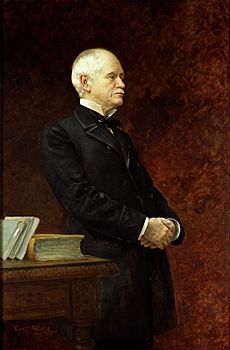
The Panic of 1893 had damaged labor conditions across the United States, and the victory of anti-silver legislation worsened the mood of western laborers. A group of workingmen led by Jacob S. Coxey began to march east toward Washington, D.C., to protest Cleveland's policies. This group, known as Coxey's Army, agitated in favor of a national roads program to give jobs to workingmen, and a weakened currency to help farmers pay their debts. By the time they reached Washington, only a few hundred remained, and when they were arrested the next day for walking on the lawn of the United States Capitol, the group scattered. Even though Coxey's Army may not have been a threat to the government, it signaled a growing dissatisfaction in the West with Eastern monetary policies.
Cleveland also intervened in the 1894 Pullman Strike to keep the railroads moving, angering both Illinois Democrats and labor unions nationwide.
Foreign policy, 1893–1897
When Cleveland took office, he faced the question of Hawaiian annexation. In his first term, he had supported free trade with the Hawaiian Kingdom and accepted an amendment that gave the United States a coaling and naval station in Pearl Harbor. A treaty of peace and friendship existed between the United States and Hawai'i. In the intervening four years, however, Honolulu businessmen of European and American ancestry had denounced Queen Liliuokalani as a tyrant who rejected constitutional government. In January 1893 they overthrew her, set up a provisional government under Sanford B. Dole, and sought to join the United States. The Harrison administration had quickly agreed with representatives of the new government on a treaty of annexation and submitted it to the Senate for approval. However, the presence in Honolulu of U.S. Marines from the USS Boston while the coup unfolded, deployed at the request of U.S. Minister to Hawaii John L. Stevens, caused serious controversy. Five days after taking office on March 9, 1893, Cleveland withdrew the treaty from the Senate and sent former Congressman James Henderson Blount to Hawai'i to investigate the situation.
Cleveland agreed with Blount's report, which found the native Hawaiians to be opposed to annexation; the report also found U.S. diplomatic and military involvement in the coup. It included over a thousand pages of documents. A firm anti-imperialist, Cleveland opposed American actions in Hawaii and called for the queen to be restored; he disapproved of the new provisional government under Dole. By December 1893, the matter was still unresolved, and Cleveland referred the issue to Congress. Cleveland delivered a December 18, 1893, message to Congress, rejecting annexation and encouraging Congress to continue the American tradition of non-intervention. Cleveland later dropped his push to restore the queen, and went on to recognize and maintain diplomatic relations with the new Republic of Hawaii under President Dole, who took office in July 1894.
Closer to home, Cleveland adopted a broad interpretation of the Monroe Doctrine that not only prohibited new European colonies, but also declared an American national interest in any matter of substance within the hemisphere.
Retirement (1897–1908)
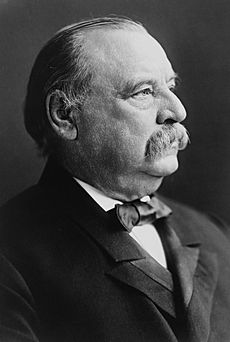
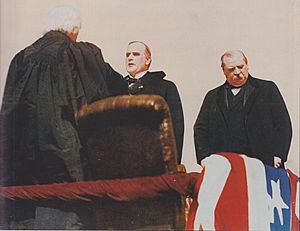
After leaving the White House on March 4, 1897, Cleveland lived in retirement at his estate, Westland Mansion, in Princeton, New Jersey. For a time, he was a trustee of Princeton University, and was one of the majority of trustees who preferred the dean Andrew Fleming West's plans for the Graduate School and undergraduate living over those of Woodrow Wilson, then president of the university. Cleveland consulted occasionally with President Theodore Roosevelt (1901–1909) but was financially unable to accept the chairmanship of the commission handling the Coal Strike of 1902. Cleveland still made his views known in political matters. In a 1905 article in The Ladies Home Journal, Cleveland weighed in on the women's suffrage movement, writing that "sensible and responsible women do not want to vote. The relative positions to be assumed by men and women in the working out of our civilization were assigned long ago by a higher intelligence."
Death
Cleveland's health had been declining for several years, and in the autumn of 1907 he fell seriously ill. In 1908, he suffered a heart attack and died on June 24 at age 71 in his Princeton residence. His last words were, "I have tried so hard to do right." He is buried in the Princeton Cemetery of the Nassau Presbyterian Church.
Marriage and children
Cleveland was 47 years old when he entered the White House as a bachelor. His sister Rose Cleveland joined him, acting as hostess for the first two years of his administration. Unlike the previous bachelor president James Buchanan, Cleveland did not remain a bachelor for long. In 1885 the daughter of Cleveland's friend Oscar Folsom visited him in Washington. Frances Folsom was a student at Wells College. When she returned to school, President Cleveland received her mother's permission to correspond with her, and they were soon engaged to be married. The wedding occurred on June 2, 1886, in the Blue Room at the White House. Cleveland was 49 years old at the time; Frances was 21. He was the second president to wed while in office and remains the only president to marry in the White House.
The Clevelands had five children: Ruth (1891–1904), Esther (1893–1980), Marion (1895–1977), Richard (1897–1974), and Francis (1903–1995). British philosopher Philippa Foot (1920–2010) was their granddaughter. Ruth contracted diphtheria on January 2, 1904, and died five days after her diagnosis. The Curtiss Candy Company would later assert that the "Baby Ruth" candy bar was named after her.
Honors and memorials
In his first term in office, Cleveland sought a summer house to escape the heat and smells of Washington, D.C., near enough the capital. He secretly bought a farmhouse, Oak View (or Oak Hill), in a rural upland part of the District of Columbia, in 1886, and remodeled it into a Queen Anne style summer estate. He sold Oak View upon losing his bid for re-election in 1888. Not long thereafter, suburban residential development reached the area, which came to be known as Oak View, and then Cleveland Heights, and eventually Cleveland Park. The Clevelands are depicted in local murals.
Grover Cleveland Hall at Buffalo State College in Buffalo, New York is named after Cleveland. Cleveland Hall houses the offices of the college president, vice presidents, and other administrative functions and student services. Cleveland was a member of the first board of directors of the then Buffalo Normal School. Grover Cleveland Middle School in his birthplace, Caldwell, New Jersey, was named for him, as is Grover Cleveland High School in Buffalo, New York, and the town of Cleveland, Mississippi. Mount Cleveland, a volcano in Alaska, is also named after him. In 1895 he became the first U.S. president who was filmed.
The first U.S. postage stamp to honor Cleveland appeared in 1923. This twelve-cent issue accompanied a thirteen-cent stamp in the same definitive series that depicted his old rival, Benjamin Harrison. Cleveland's only two subsequent stamp appearances have been in issues devoted to the full roster of U.S. Presidents, released, respectively, in 1938 and 1986.
Cleveland's portrait was on the U.S. $1000 bill of series 1928 and series 1934. He also appeared on the first few issues of the $20 Federal Reserve Notes from 1914. Since he was both the 22nd and 24th president, he was featured on two separate dollar coins released in 2012 as part of the Presidential $1 Coin Act of 2005.
In 2013, Cleveland was inducted into the New Jersey Hall of Fame.
Images for kids
-
Cleveland's first Cabinet. Front row, left to right: Thomas F. Bayard, Cleveland, Daniel Manning, Lucius Q. C. Lamar Back row, left to right: William F. Vilas, William C. Whitney, William C. Endicott, Augustus H. Garland
-
Cleveland's last Cabinet. Front row, left to right: Daniel S. Lamont, Richard Olney, Cleveland, John G. Carlisle, Judson Harmon Back row, left to right: David R. Francis, William Lyne Wilson, Hilary A. Herbert, Julius S. Morton
See also
 In Spanish: Grover Cleveland para niños
In Spanish: Grover Cleveland para niños
- Grover Cleveland Birthplace
- Presidencies of Grover Cleveland


